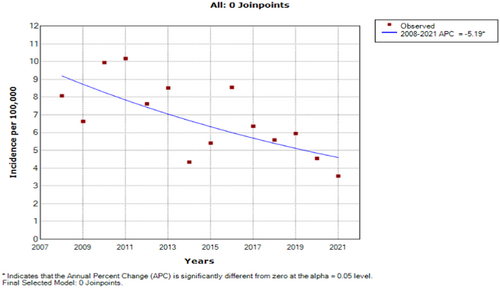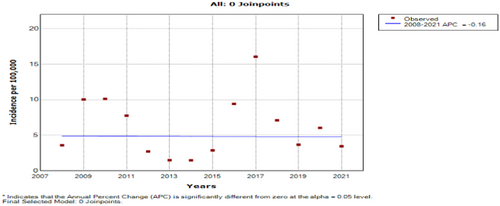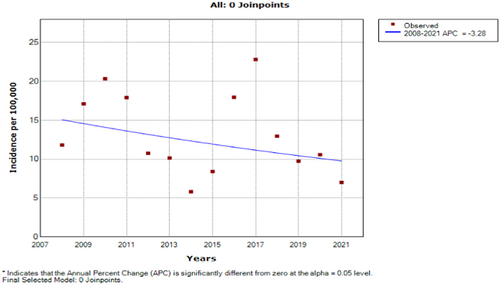Epidemiological study of hepatitis B and hepatitis C infection in Kohgiluyeh and Boyer-Ahmad province (Iran) from 2008 to 2021: A cross-sectional study
Abstract
Background and Aims
Viral hepatitis is one of the top five reasons people die from infections all around the world. The present study aimed to assess the epidemiological features of hepatitis B and hepatitis C infections in Kohgiluyeh and Boyer-Ahmad province.
Methods
The data were obtained via the census method from the registered hepatitis B and hepatitis C data in the reportable disease care system of Yasuj University of Medical Sciences. The collected data are the result of serological tests. The χ2 test was used to evaluate the important risk factors for hepatitis B virus (HBV) and hepatitis C virus (HCV) infection. The joinpoint regression was performed to investigate the trend of HBV and HCV in recent years.
Results
Here, 1270 cases of hepatitis B and C were identified and reported in Kohgiluyeh and Boyer-Ahmad province from 2008 to 2021. The median age of patients was 38 (interquartile range: 31–51), varying significantly according to the type of hepatitis. The most common hepatitis in males was hepatitis C and in females, hepatitis B. Regarding the place of residence, HBV and HCV were both more prevalent in urban areas. The age group of 25–34 years has the highest prevalence of HBV and HCV. According to the joinpoint regression analysis, there is a decrease in the 14-year trend of incidence rate due to total hepatitis B and C: the annual percent change was −5.2% (95% confidence interval [CI]: −8.4 to −1.9, p = 0.005) for hepatitis B and −0.2% (95% CI: −10.7 to 11.6, p = 0.976) for hepatitis C.
Conclusion
This study shows the incidence rate of hepatitis B has been decreasing during the years of study but this trend has been stable for hepatitis C. Also, the highest number of cases of hepatitis B and C were reported in the age groups of 25–34 years. Hence, preventive interventions are vital in reducing the burden of these diseases.
1 INTRODUCTION
Hepatitis is inflammation of the liver caused by a variety of infectious viruses and noninfectious pathogens, leading to a variety of health problems, some of which can be fatal.1 There are five major strains of hepatitis viruses, called types A, B, C, D, and E.1
All of these cause liver disease, but they differ in important ways, including route of infection, severity of disease, geographic distribution, and methods of prevention.2 Types B and C in particular cause chronic disease in hundreds of millions of people, and together they are the most common cause of cirrhosis, liver cancer, and viral hepatitis-related deaths.3 vaccination can prevent some types of hepatitis.1 One study found that vaccinations, diagnostic tests, medicines and education campaigns could prevent an estimated 4.5 million premature deaths in low- and middle-income countries by 2030.1 The World Health Organization (WHO) Global Hepatitis Strategy is supported by all WHO Member States and aims to reduce new hepatitis infections by 90% and deaths by 65% from 2016 to 2030.1
Health policy and decision makers are considering hepatitis C virus (HCV) infection as a major public health concern because it poses a substantial burden from both an epidemiological and clinical perspective.2 High-risk groups such as prisoners, people living with human immunodeficiency virus (HIV), people receiving blood products, and people who inject drugs (PWIDs) are at serious risk of HCV.3 The WHO estimates that there were ~1.75 million new infections worldwide in 2015. According to the WHO, the highest infection rates were in the Eastern Mediterranean region (2.3%) and the European region (1.5%).3 The risk of HCV infection in these people is higher than that of people with HIV.4
Identification of high-risk groups can greatly help health systems to prevent and control various infectious diseases.5-8 The global prevalence of HCV is reported to be ~1%–2%, with over 170 million people infected worldwide. Each year, more than 350,000 people die from the disease and three to four million new cases of HCV infection are diagnosed.9 In Iran, the incidence of her HCV in the general population is estimated to be 0.6.10, 11 WHO has identified the 2030 HCV elimination plan as an important and ambitious goal. Therefore, one of the most important ways to achieve this goal is to screen and control the disease in high-risk groups such as PWID.12, 13 Hepatitis B (HB) is a viral infection that affects liver tissue and can cause other acute and chronic liver diseases.14 The result of a modeling study in 2016 showed the global prevalence of hepatitis B surface antigen (HBsAg)-positive HB was 3.9% (95% uncertainty interval: 3.4–4.6).15 Finally, the highest rates of HB are reported in Africa and East Asia.16-19 Iran is classified as a low- to intermediate-prevalence area.14 The last meta-analysis conducted on the general population of Iran showed the prevalence of HB was ~2.2% in 2016.14 Considering that no study has been conducted on the incidence of hepatitis B and hepatitis C in Kohgiluyeh and Boyer-Ahmad province in southwestern Iran, the present study aimed to investigate the epidemiological features of hepatitis B and hepatitis C in this province from 2008 to 2021.
2 MATERIALS
In this cross-sectional study, the registered viral hepatitis B and hepatitis C data from 2008 to 2021 were extracted from the reportable disease care system of Yasuj University of Medical Sciences. The target population of the study was obtained based on the national censuses of 2011 and 2016, and the population of other years was estimated using population growth. Kohgiluyeh and Boyer-Ahmad province is located in the south of Iran. And according to the latest general population and housing census, the population the population of this province is 713,052 (2016 census).
According to the National Guide to Hepatitis Care and Treatment, it is mandatory to report hepatitis B and C infections in Iran. Therefore, all public and private laboratories, blood transfusion organizations, hospitals, and health centers must report all positive serological results to the health center of the city every month. The inclusion criteria were people living in Kohgiluyeh and Boyer-Ahmad, as well as confirmed cases and new patients. The variables extracted from patients included age, gender, occupation, type of hepatitis, place of residence, the reason for testing, source of reporting, marital status, clinical symptoms, and disease outcome. Serological tests and antibody tests have been used to diagnose hepatitis. The total estimated population of Kohgiluyeh and Boyer-Ahmad Province was estimated using the data available in health centers, as well as the population and housing census from 2006 to 2016, taking into account the annual population growth.
2.1 Statistical analysis
In this study, descriptive analyses were initially performed and a χ2 test was then used to compare some types of HBV infections, (HCV) HBV, HBV, and HCV, based on the mentioned variables. The incidence per 100,000 population for hepatitis B and hepatitis C infections has been calculated based on years of study and age groups. As the age variable was not normally distributed, the Mann–Whitney test was used to compare the mean age in terms of HBV and HCV. p < 0.05 were considered as statistically significant. We used two-sided tests in the statistical analysis. The data were analyzed in Excel (version 2016) and SPSS (version 25).
To examine the trend of incidence rate over the different years, joinpoint regression based on the log-linear model was used. Joinpoint regression analysis is used to examine trend changes in successive periods and also to quantify the increase or decrease in each period. The resulting line segment between joinpoints is described by the annual percent change (APC), based on the slope of the line segment and the average APC (AAPC). This analysis fits a series of straight lines on a log scale to provide the annual percentage change (APC) in rates and specifies the point in time (calendar years) at which trends change significantly.20 The opposite of linear regression is based on slope and log-linear regression is based on the APC.21
Joinpoint regression analysis was performed using Joinpoint Regression Program (version 4.9.0.0). The protocol of this study was reviewed and approved by the Ethics Committee of Yasuj University of Medical Sciences. According to this code of ethics, all aspects of the study were conducted. IR.YUMS.REC.1401.101.
3 RESULTS
In this cross-sectional study, 1270 cases of hepatitis B and C were identified and reported in Kohgiluyeh and Boyer-Ahmad province from 2008 to 2021. Out of these patients, 657 (51.7%), 596 (46.9%), and 17 (1.4%) subjects were infected with HBV, HCV, and HB–HCV, respectively. The median age of all patients was 38 years (interquartile range [IQR]: 31–51) (Table 1).
| Variable | Total (N = 1270) | HBV (N = 657) | HCV (N = 596) | p | HBV & HCV (N = 17) |
|---|---|---|---|---|---|
| Age (IQR) | 38.0 (31.0–51.0) | 42.0 (31.0–56.0) | 35.0 (30.0–43.0) | <0.001 | 41.5 (33.0–55.0) |
| Gender | |||||
| Female | 313 (24.6) | 249 (79.6) | 61 (19.5) | <0.001 | 3 (0.9) |
| Male | 957 (75.4) | 408 (42.7) | 535 (55.9) | 14 (1.5) | |
| Marital status | |||||
| Married | 848 (66.8) | 548 (64.6) | 292 (34.4) | <0.001 | 8 (0.9) |
| Single | 365 (28.7) | 87 (23.8) | 270 (74.0) | 8 (2.2) | |
| Divorce & widow | 49 (3.9) | 20 (40.8) | 28 (51.1) | 1 (2.0) | |
| Job | |||||
| Unemployed | 275 (21.8) | 74 (26.9) | 198 (72.0) | <0.001 | 3 (1.1) |
| Employed | 130 (10.3) | 106 (81.5) | 23 (17.7) | 1 (0.8) | |
| Household | 263 (20.8) | 220 (83.7) | 40 (15.2) | 3 (1.1) | |
| Others | 595 (47.1) | 252 (42.4) | 333 (56.0) | 10 (1.6) | |
| Region | |||||
| Urban | 867 (68.3) | 372 (42.9) | 487 (56.2) | <0.001 | 8 (0.9) |
| Rural | 403 (31.7) | 285 (70.7) | 109 (27.0) | 9 (2.3) | |
| Examination cause | |||||
| High risk behavior | 467 (36.8) | 169 (36.2) | 292 (62.5) | <0.001 | 6 (1.3) |
| Pregnancy | 64 (5.0) | 58 (90.6) | 6 (9.4) | 0 (0.0) | |
| Clinical symptoms | 295 (23.2) | 178 (60.3) | 113 (38.3) | 4 (1.4) | |
| Voluntarily | 252 (19.8) | 140 (55.6) | 111 (44.0) | 1 (0.4) | |
| Other | 192 (15.1) | 112 (58.3) | 74 (38.5) | 6 (3.2) | |
| Source of reporting | |||||
| Clinic | 304 (23.9) | 95 (31.3) | 203 (66.7) | <0.001 | 6 (2.0) |
| Laboratory | 353 (27.8) | 208 (58.9) | 142 (40.2) | 3 (0.9) | |
| Hospital | 89 (7.0) | 51 (57.3) | 36 (40.4) | 2 (2.3) | |
| Public Health Center | 479 (37.7) | 282 (58.9) | 192 (40.1) | 5 (1.0) | |
| Blood transfusion center | 30 (2.4) | 20 (66.7) | 9 (30.0) | 1 (3.3) | |
| Outcome | |||||
| Recovery | 37 (2.9) | 20 (54.1) | 16 (43.2) | 0.01 | 1 (2.7) |
| Death | 11 (0.9) | 11 (100.0) | 0 (0.0) | 0 (0.0) | |
| Needs follow-up | 969 (76.3) | 500 (51.6) | 456 (47.1) | 13 (1.3) | |
| Unknown | 253 (19.9) | 126 (49.8) | 124 (49.0) | 3 (1.2) | |
| Symptoms | |||||
| Nausea | 191(15.0) | 116 (60.7) | 69 (36.1) | 0.002 | 6 (3.2) |
| Fever | 161 (12.7) | 79 (49.1) | 80 (49.7) | 0.45 | 2 (1.2) |
| Abdominal pain | 243 (19.1) | 150 (61.7) | 90 (37.0) | 0.001 | 3 (1.2) |
| Weakness | 41 (3.2) | 20 (48.8) | 21 (51.2) | 0.63 | 0 (0.0) |
| Vomiting | 196 (15.4) | 121 (61.7) | 69 (35.2) | 0.001 | 6 (3.1) |
| Jaundice | 274 (21.6) | 159 (58.0) | 111 (40.5) | 0.01 | 4 (1.5) |
| Asymptomatic | 587 (46.2) | 313 (53.3) | 267 (45.5) | 0.31 | 7 (1.2) |
- Abbreviations: HBV, hepatitis B virus; HCV, hepatitis C virus; IQR, interquartile range.
As illustrated in Table 1, the median age of patients with HBV was higher than that of patients with HVC, and this difference was statistically significant (p < 0.001). The median age scores in patients with HBV and HCV were 42.0 (IQR: 31.0–56.0) and 35.0 (IQR: 30.0–43.0), respectively.
In terms of gender, 957 (75.4%) patients were male, and hepatitis C and hepatitis B were the most common types of infection in males and females, respectively. Moreover, 848 (66.8%) patients were married and 479 (37.7%) cases were reported by health centers. In 467 (36.8%) patients, the primary reason for taking a test was high-risk behaviors (Table 1). Moreover, 287(22/6(% patients were fully vaccinated against hepatitis B, 73 (5.7%) cases were incompletely vaccinated, and 910 (71.7%) patients were not vaccinated against hepatitis B.
As illustrated in Figure 1, the highest and lowest number of cases of hepatitis B and C were reported in the age groups of 25–34 and 0–14 years, respectively. There was a statistically significant difference between hepatitis types in terms of gender, marital status, occupation, place of residence, reason for testing, source of reporting, and outcome (p < 0.05). Moreover, clinical symptoms, such as nausea, abdominal pain, vomiting, and jaundice were more frequently observed in patients with hepatitis B (p < 0.05) (Table 1).

Based on the joinpoint regression analysis, the 14-year trend of incidence rate due to total hepatitis B and C was decreasing: the APC was −5.2% (95% CI: −8.4 to −1.9, p = 0.005) for hepatitis B, −0.2% (95% CI: −10.7 to 11.6, p = 0.97) for hepatitis C, and −3.3% (95% CI: −8.7 to 2.5, p = 0.23) for both hepatitis. The model did not show any joinpoint; hence, the AAPC is the same as the APC (Figures 2-4).



Based on the results of joinpoint regression, the incidence of hepatitis B decreased significantly during the study period. However, this trend has been stable for hepatitis C.
4 DISCUSSION
In the present study, the results of joint point analysis demonstrated that the incidence rate of hepatitis B and C had a downward trend from 2008 to 2021. In this regard, an international study which was conducted in 161 countries pointed out that the global prevalence of the HBsAg was 3.61%, with the highest prevalence being reported in African countries (8.83%) and the western Pacific region (5.26%), respectively. The wide differences observed among countries can be attributed to various risk factors or modes of transmission.22 In a meta-analysis, the prevalence of hepatitis B ranged from 0.1% in Ireland to 4.4% in Romania.23 In a meta-analysis conducted in Nigeria from 2000 to 2013, the prevalence of hepatitis B was reported to be 13.6%, which had a declining trend.24 In the last decade, the prevalence of HBV in Iran has dramatically decreased and our country is currently regarded as a country classified as a region with a low prevalence of HBV.10, 11, 22, 24, 25
The declining trend of HBsAg-positive cases in the present study, compared to the reported percentage of positive cases in our country, can be ascribed to the successful implementation of the national HBV immunization program in the province, an increased level of public knowledge and awareness, screening blood donors, safe injections among drug users, full coverage of appropriate medications and treatments,26 and timely screening of pregnant women.23 Other studies indicated a decrease in the prevalence of HBsAg in most countries.27 Regarding the gender distribution of HBV infection, similar to the results of national studies in which 65% of HBV patients were male, the majority of patients (62.1%) were male in the present research.28
In the study by Yazhan et al.,27 HBV infection had a higher prevalence in females, as compared to that in males (3.9 vs. 2.91).27 Moreover, in a study by Hariri et al.,10 the prevalence rates of HBV infection in males and females were 60.3% and 39.7%, respectively. In the study of chronic carriers of hepatitis, the prevalence of HBsAg in male blood donors was approximately five times higher than that in females.29 In a study by Ghadir,30 prevalence rates of HBV infection were 56% and 44% in males and females, respectively, and in a study by Jalilian et al.,31 these rates were 72% and 28% in males and females, respectively.
In a study by Karimi et al.,32 in terms of gender, more positive cases were reported in males and females women (57% vs. 43%). In the same context, Kasraian et al.33 in Shiraz demonstrated that the prevalence rates of HBV infection were 96.6% and 3.4% in males and females, respectively. In the study by Hariri et al.,10 the prevalence rates of HCV infection were 61.2% and 38.8% in males and females, respectively. In the present study, the prevalence rates of HCV infections were 10.2% and 13.10% in males and females, respectively.
In a study by Hajiani et al.,34 the prevalence rates of HCV infection were 63% and 37% in males and females, respectively. Nonetheless, in the study by Yazhan et al.,27 the prevalence of HCV was equivalent in males and females. In addition, in the study by Rezaei et al.,35 88.46% and 11.54% of patients with HCV infection were male and female, respectively. The higher prevalence of hepatitis among males can be attributed to such factors as a broader proportion of male drug users, especially injection and the use of shared syringes, a higher number of male prisoners, and the prevalence of high-risk sexual behaviors.
Regarding age, the majority of HBV patients in this study were in the age group of 25–34 and 35–44 years, respectively. Moreover, consistent with the results of other studies, most HCV patients in this research were observed in the age group of 25–34 years.36, 37 In a study conducted in Indonesia, the highest prevalence rates of HBV and HCV were in the age groups of 45–49 and over 60 years, respectively.38 In addition, the high prevalence in this age group in our study can be ascribed to the fact that these individuals are at their sexual peak and more inclined to use injection drugs; therefore, they are more exposed to risk factors for HBV infection, as compared to other age groups.27
The median age scores of patients with HBV and HCV in this study were 42.0 (IQR: 31.0–56.0) and 35.0 (IQR: 30.0–43.0) years, respectively. In the study by Karimi et al.,32 97% of patients with HBV infection were over 20 years old (ages before the implementation of the national HBV immunization program in Iran). That is to say, the mean age of these people was reported to be 15.5 ± 37.6 years.32 The course of HBV infection is directly related to the age of onset so that it is acute (with or without symptoms) in 90% of adults, whereas 90% of infants with HBV go on to develop chronic infection.39
In a study by Mirzaei et al.,28 the highest frequency of patients was in the age group of 20–39 years and the highest incidence was in the sixth decade of life, indicating that the incidence of the disease increases with age. However, the incidence of the disease decreases after the sixth decade of life (age group 69–60 years).28 By the results of several other studies,27, 33, 35, 40, 41 and inconsistent with those reported in one study,41 in the present research, most HCV- and HBV-positive cases were married. The higher infection among married people can be related to the lack of serious sexual counseling and premarriage medical tests.27 In line with the results of studies by Karimi et al.32 and Mirzaei et al.,28 56.7% and 81.7% of HBV and HCV patients resided in cities.
Consistent with the results of similar studies,42-44 the highest frequency of HBV infection in this study was observed in housewives. Moreover, the highest frequency of HCV infection was detected in people who did not work in government organizations. This high prevalence can be ascribed to more frequent risky behaviors in these people.27
Among the notable limitations of this study, we can refer to the incomplete registration of necessary information in the epidemiological examination of viral hepatitis form, which made it difficult to interpret the available data and arrive at a valid conclusion.
In our study, 25.7% of people with hepatitis B and 49% of people with hepatitis C had risky behaviors. The results of our study showed that 8.8% of pregnant women had hepatitis B and 1% had hepatitis C. Of the people with viral hepatitis, 19.8% volunteered to be tested.39 In the study of Nateghi et al., 1.9% of people had referred voluntarily.
Previously, the role of blood transfusion, surgery, transmission from family members, dental intervention, endoscopy, hemodialysis and tattooing, behaviors related to injecting drugs, the duration of injectable addiction, the type of injected substance, and the use of common syringes (directly and indirectly with the spread of hepatitis B and C) have been related.43-45
In total, 23.2% of people went to the doctor because of symptoms and signs of the disease, which ratio was 27.1% in patients with hepatitis B and 19% in patients with hepatitis C. Most patients with chronic hepatitis C are asymptomatic or have brief nonspecific symptoms. About 70% of acute hepatitis are asymptomatic or have brief clinical symptoms, and only 30% of patients manifest as a swollen jaundice.45
One of the limitations of our study was the calculated amounts and percentages from the data of the national report of hepatitis cases, which are less likely to be reported. Another limitation of our study was the lack of access to hepatitis B/C negative cases.
5 CONCLUSION
According to the findings of this study, the incidence rate of hepatitis B has been decreasing during the years of study, but this trend has been stable for hepatitis C. Also, the highest number of cases of hepatitis B and C were reported in the age groups of 25–34 years. Hence, preventive interventions, including educational programs, safe blood transfusions, vaccination of neonates and high-risk groups, and the evaluation of antibody levels after vaccination to assess the level of immunity to control HBV, as well as timely identification and treatment of patients with effective drugs to eliminate HCV, are vital in reducing the burden of these diseases.
AUTHOR CONTRIBUTIONS
Sayed H. Faghihi: Conceptualization; data curation; validation; writing—review and editing. Habibollah Azarbakhsh: Methodology; software; writing—original draft; writing—review and editing. Elahe Piraee: Conceptualization; investigation; methodology; writing—original draft; writing—review and editing.
CONFLICT OF INTEREST STATEMENT
The authors declare no conflict of interest.
ETHICS STATEMENT
The protocol of this study was reviewed and approved by the Ethics Committee of Yasuj University of Medical Sciences. All aspects of the study were conducted according to the university's code of ethics IR.YUMS.REC.1401.101
TRANSPARENCY STATEMENT
The lead author Elahe Piraee affirms that this manuscript is an honest, accurate, and transparent account of the study being reported; that no important aspects of the study have been omitted; and that any discrepancies from the study as planned (and, if relevant, registered) have been explained.
Open Research
DATA AVAILABILITY STATEMENT
The data will be available upon request.




